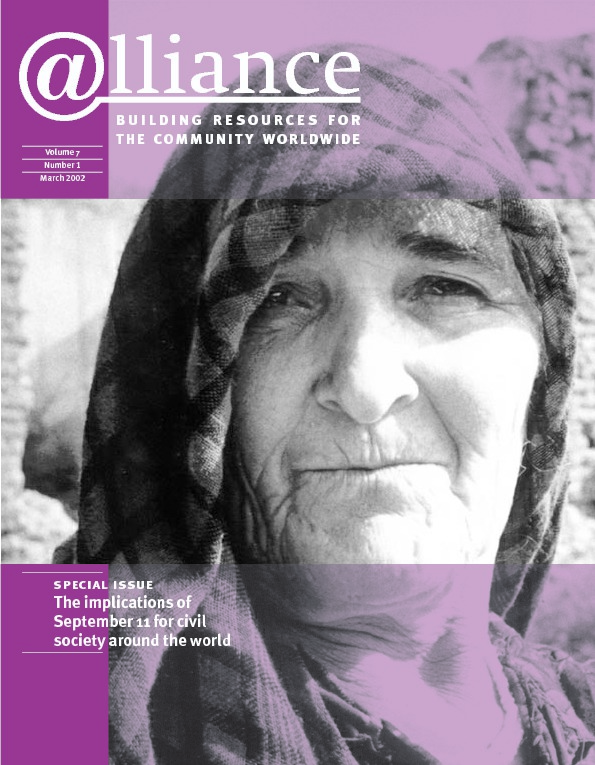In comparison with European foundations, some of the larger and most highly respected US foundations fund with real global vision. They are flexible, enlightened grantmakers that are prepared to adapt as they take risks and act fast. Why are the Europeans so much slower to take on a significant international role?
Though the great bulk of grantmaking by US foundations is directed at domestic problems, a significant number have a great track record in international grantmaking. These global agendas result in a much greater involvement in large-scale initiatives. This has meant that they can and do respond expeditiously to global changes and challenges such as the fall of the Berlin Wall and the subsequent opening up of Central and Eastern Europe and the end of Apartheid in South Africa.
Why do US funders have this global vision?
I don’t think that the fact that US foundations have a lot of money available – and must, by law, grant a minimum of 5 per cent of their assets each year or lose their tax- exempt status – is the main reason for this. At least as significant is the way in which the philanthropic community relates to the state – which is very different from the relationship between the state and most European foundations. To some extent, US foundations have filled a void left by a US government that is increasingly less interested in global issues. From my perspective, this looks like privatization by default. A 1997 report published by the Rockefeller Brothers Fund refers to this as a falling behind in social stewardship.[1] Whether the 11 September tragedy will increase the interest the US government takes in international affairs and in international cultural dialogue remains to be seen.
It may also be that some of our US foundation colleagues[2] take a more serious interest in emerging public policy issues than their European counterparts. They are often the first to realize that changes that occur in the world may have a significant impact on the functioning of society at large. They, not their European counterparts, were the first to respond to the changed circumstances in Central and Eastern Europe – though the region is of strategic importance to Europe. If it were not for the US foundations, there would not have been the same concerted effort that has given such a stimulus to the development of civil society in the region.
Challenges for European foundations
What about European foundations? The first thing that strikes me is that most European foundations operate in a national context. European unification, the enlargement of Europe and the introduction of a common currency certainly should encourage them to become more international in their outlook.
European foundations also need to be more willing to take positions contrary to the government. They must move away from being simply charities and become more strategic in their orientation, aiming to inform and influence both practice and policy. They must become more open-minded and flexible. In comparison with their American counterparts, European foundations generally are still rather rigid in the interpretation of their funding guidelines.
Finally, European foundations need to resist transforming themselves into mainstream funders, thereby taking over the responsibilities of governments. Governments often like the ideas and policies that foundations have developed and try to convince them that they should also be responsible for their system-wide implementation.
Re-examining foundations’ role
In fact, foundations do need to re-examine the role they play, and to determine where, on the continuum from catalyst to mainstream service provider, they should principally operate, and where governments should take first responsibility.
The traditional view is that playing the role of innovators and catalysts is what foundations do best. But European foundations need to become more active in ensuring that effective initiatives move to scale. It is no longer enough to test successful new approaches at the micro level and then hand them over to government to move them to the macro level. There is little benefit if new initiatives, created with seed money, do not survive and grow. Foundations ought to be involved as facilitators (even financially) in the process of influencing policy and going to scale. This does not imply that they take over from government. On the contrary, they must maintain their role as change agents but extend this role to include promoting the system-wide application of new approaches.
If foundations work in partnership with government, there are advantages for both sides. The advantage for foundations is the possibility of moving to scale and having an impact because of access to public funds and a legislative framework. The advantages for government include tapping into foundations’ innovative thinking, risk-taking attitude and knowledge.
Partnering with US foundations
If there are lessons to be learned from the US, then we should look for partnerships with our American colleagues. But these must be real partnerships, not just afterthoughts as they sometimes seem to be at present when, at five minutes before midnight, US foundations approach their European counterparts to partner with them in an important global initiative of which the parameters have already been set. Of course there are exceptions – the Trust for Civil Society in Central and Eastern Europe is one.
A major problem here is, as already mentioned, that US foundations take the initiative while the Europeans are slower in their response to global challenges. In that sense we deserve what we get.
On the other hand, European foundations can bring real benefits to such partnerships. One is diversity. European foundations experience a variety of cultures in many different countries, each with its own essential national character, values and political structures. How much richer the entire civil society initiative in Central and Eastern Europe would have been if European foundations had brought in other perspectives and the emerging civil societies had not been constrained by being expected to converge on a single model. The allocation and delivery of public services is just one area where the range of experience of European foundations would have been valuable.
Partnering with the European Commission
Partnerships with the European Commission are another option – provided the EC understands what foundations do and does not look upon them simply as useful allies in times of budgetary shortfall.
What could such partnerships mean in practice? The Commission has considerable funds to spend on civil society development, but does it have the capacity to do this effectively?
The EFC has already suggested on a number of occasions that the EC should consider a re-granting strategy. This is a highly cost-effective option in that large numbers of community-based organizations and initiatives can be reached with a minimum of administrative work and expense for the EC. Ideally, re-granting would be done by indigenous intermediary organizations. They are much more accessible to local grantseekers than the EC or faraway international foundations. They understand the local conditions and are therefore well placed to make decisions. Additionally, working through indigenous organizations is an investment in civil society. Both the EC and international foundations could channel funds to CBOs through these local intermediaries, but the foundations also have much to offer in terms of their grantmaking expertise and experience.
Further development of this model could lead to the creation of endowments. This could help to smooth the accession of Central and Eastern Europe countries to the EU. One current problem is that money has to be spent too quickly. This leads to large-scale projects, while the local absorption capacity is questionable. As the EU grows, the functioning of the Commission will become more complicated and further delays in disbursing funds are likely.
Using EC financial resources to endow intermediary grantmakers would be a way of ensuring long-term continuity of funding for the structural changes that EU accession demands. While EC funds are used to endow the intermediary organizations, foundation money could be directly re-granted to the final recipients.
I’m not going to pretend that this kind of partnership is some kind of magic wand, but experience of working with indigenous, endowed re-granting organizations is growing. A recently published World Bank report on community development foundations[3] quotes many good examples from Africa and Latin America. Through such community development foundations, donors can enhance the impact of their funding and expertise on sustainable development.
1 RBF (1997) Global Interdependence and the Need for Social Stewardship New York.
2 These include the German Marshall Fund and the Ford, Mott, Kellogg, UN and Rockefeller Foundations.
3 Joyce Malombe (2000) Community Development Foundations: Emerging partnerships World Bank, Washington DC.
Rien van Gendt is Executive Director of the Van Leer Group Foundation and Chairman of the International Committee of the European Foundation Centre. He can be contacted by email at rien.vangendt@bvleerf.nl
This article is a shorter version of a speech given at the European Foundation Leaders Summit, 9 November 2001.






Comments (0)